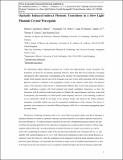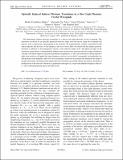Files in this item
Optically induced indirect photonic transitions in a slow light photonic crystal waveguide
Item metadata
| dc.contributor.author | Munoz, Michel Castellanos | |
| dc.contributor.author | Petrov, Alexander Yu. | |
| dc.contributor.author | O'Faolain, Liam | |
| dc.contributor.author | Li, Juntao | |
| dc.contributor.author | Krauss, Thomas F. | |
| dc.contributor.author | Eich, Manfred | |
| dc.date.accessioned | 2014-07-24T13:31:01Z | |
| dc.date.available | 2014-07-24T13:31:01Z | |
| dc.date.issued | 2014-02-07 | |
| dc.identifier | 135025347 | |
| dc.identifier | 7ad4a006-805e-4f8d-bb62-4e471b81d56c | |
| dc.identifier | 000331950100008 | |
| dc.identifier | 84894505152 | |
| dc.identifier | 000331950100008 | |
| dc.identifier.citation | Munoz , M C , Petrov , A Y , O'Faolain , L , Li , J , Krauss , T F & Eich , M 2014 , ' Optically induced indirect photonic transitions in a slow light photonic crystal waveguide ' , Physical Review Letters , vol. 112 , no. 5 , 053904 . https://doi.org/10.1103/PhysRevLett.112.053904 | en |
| dc.identifier.issn | 0031-9007 | |
| dc.identifier.uri | https://hdl.handle.net/10023/5073 | |
| dc.description | M.C.M., A.Y.P. and M.E. acknowledge the support of the German Research Foundation under Grant EI 391/13-2, and appreciate the support of CST, Darmstadt, Germany, with their Finite Integration Software Microwave Studio. J.L. acknowledges the support of the National Natural Science Foundation of China (11204386), the Guangdong Natural Science Foundation (S2012040007812) and NKBRSF (G2010CB923200). T.F.K. and L.O’F acknowledge support by the EPSRC through the UK Silicon Photonics consortium. | en |
| dc.description.abstract | We demonstrate indirect photonic transitions in a silicon slow light photonic crystal waveguide. The transitions are driven by an optically generated refractive index front that moves along the waveguide and interacts with a signal pulse copropagating in the structure. We experimentally confirm a theoretical model which indicates that the ratio of the frequency and wave vector shifts associated with the indirect photonic transition is identical to the propagation velocity of the refractive index front. The physical origin of the transitions achieved here is fundamentally different than in previously proposed refractive index modulation concepts with fixed temporal and spatial modulation frequencies; as here, the interaction with the refractive index front results in a Doppler-like signal frequency and wave vector shift. Consequently, the bandwidth over which perfect mode frequency and wave vector matching is achieved is not intrinsically limited by the shape of the photonic bands, and tuning of the indirect photonic transitions is possible without any need for geometrical modifications of the structure. Our device is genuinely nonreciprocal, as it provides different frequency shifts for co- and counterpropagating signal and index fronts. | |
| dc.format.extent | 5 | |
| dc.format.extent | 344016 | |
| dc.format.extent | 426108 | |
| dc.language.iso | eng | |
| dc.relation.ispartof | Physical Review Letters | en |
| dc.subject | Electromagnetic-waves | en |
| dc.subject | Ionization front | en |
| dc.subject | Silicon | en |
| dc.subject | Conversion | en |
| dc.subject | QC Physics | en |
| dc.subject | BDC | en |
| dc.subject | R2C | en |
| dc.subject.lcc | QC | en |
| dc.title | Optically induced indirect photonic transitions in a slow light photonic crystal waveguide | en |
| dc.type | Journal article | en |
| dc.contributor.sponsor | EPSRC | en |
| dc.contributor.institution | University of St Andrews. School of Physics and Astronomy | en |
| dc.contributor.institution | University of St Andrews. Microphotonics and Photonic Crystals Group | en |
| dc.identifier.doi | 10.1103/PhysRevLett.112.053904 | |
| dc.description.status | Peer reviewed | en |
| dc.identifier.grantnumber | EP/F001622/1 | en |
This item appears in the following Collection(s)
Items in the St Andrews Research Repository are protected by copyright, with all rights reserved, unless otherwise indicated.


